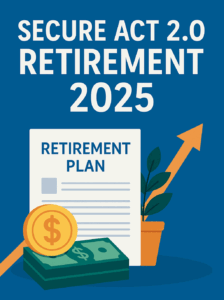
SECURE Act 2.0 Retirement 2025
SECURE Act 2.0 Retirement 2025: 4 Opportunities for Small Business Owners
The SECURE Act 2.0 retirement 2025 changes are here, offering new opportunities — and responsibilities — for small business owners and high-income professionals. In this post, I’ll explain what’s driving these changes, who can benefit, and 4 steps you can take now to make the most of them.
Why Does SECURE Act 2.0 Matter in 2025?
The original SECURE Act was passed in 2019, but its expansion — known as SECURE Act 2.0 — was signed into law at the end of 2022. Several key provisions take effect in 2025, providing enhanced tax credits, new Roth options, and updated contribution rules designed to help more Americans save for retirement.
According to the Department of Labor, many small business employees still lack access to retirement plans — something these changes aim to fix.
Who Should Pay Attention to SECURE Act 2.0 Retirement 2025?
If any of the following apply to you, these changes could significantly improve your tax and retirement planning:
✅ You don’t currently offer a retirement plan but want to start.
✅ You want to attract and retain employees by offering better benefits.
✅ You’re a high-income professional looking for additional tax-advantaged savings options.
✅ You’re interested in leveraging Roth contributions while in a lower tax bracket.
How to Take Advantage of SECURE Act 2.0 in 2025
To maximize your benefits under the new rules, consider these 4 steps:
1. Start a Retirement Plan Using New Tax Credits
Businesses with 50 or fewer employees may now qualify for tax credits covering up to 100% of the startup costs of a 401(k) or SIMPLE IRA for the first three years.
2. Offer Roth Employer Contributions
For the first time, employer contributions can now be made as Roth contributions, giving employees more flexibility and potential tax-free growth.
3. Plan for Higher Catch-Up Contributions
Beginning in 2025, employees aged 60–63 can make even larger catch-up contributions. However, high earners must make these contributions as Roth.
4. Automate Enrollment and Participation
Many new plans are now required to automatically enroll employees and increase their contributions annually — boosting participation and savings rates.
Why Act Now?
The SECURE Act 2.0 retirement 2025 rules create valuable incentives, but also impose new compliance obligations. Business owners who plan ahead can claim generous credits and avoid last-minute headaches.
Links:
– Contact TaxLane
– Department of Labor
– Senate Finance Committee SECURE Act Summary
—
**Disclaimer:** The information provided in this blog post is for informational purposes only and should not be construed as legal, tax, or accounting advice. Tax situations are often complex and highly specific to the individual or business. You should contact a qualified tax expert directly to discuss your particular circumstances. Nothing herein is intended to, nor does it, create an attorney-client or advisor-client relationship. For individual guidance, please contact us directly.


